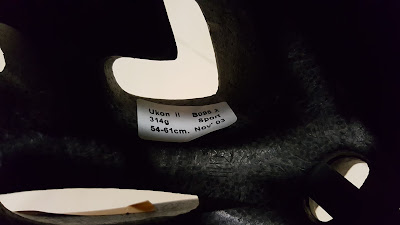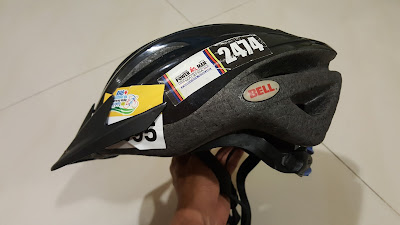Despite the wide price ranges for the various kinds of bicycle helmets out there, a take home message I have for you is that the prices generally have little to do with their level of safety. Most if not all cycling helmets sold by reputable bike stores have to comply with a minimum set of international safety standards, regardless if its an RM100 helmet or an RM1000 helmet, which makes one helmet just about as safe as any other helmet out there.
Before we get started, lets go over what a basic entry level helmet will get you. From there, I'll talk about the factors that make up higher-end helmets which play significant parts in determining their price. As a reference helmet, I'll be using my 13 year old Bell helmet. This faithful shell has seen it's fair share of thrills and spills. The countless number of falls and tumbles I've had with this helmet, both on and off the road, make it an object of significant sentimental value to me. I've used it for both mountain biking and road cycling. With it's set of specifications, I feel that it is very representative of a general entry level bike helmet.
This specific model is the Ukon 2 and cost about RM 90-RM120 all those years ago (can't quite remember). After a quick look on Amazon, I managed to find a few for about $27 - $40, which is about RM120 to RM160 according to current exchange rates, definitely still within the price range of a beginner's helmet. It weighs 314 grams and is a size 54-61cm. It also comes with a removeable visor that easily snaps into place to protect your eyes from the sun, rain and anything else that might be flying through the air. A total of 17 vents all around the helmet have done their best at keeping my head cool over the years.
This specific model is the Ukon 2 and cost about RM 90-RM120 all those years ago (can't quite remember). After a quick look on Amazon, I managed to find a few for about $27 - $40, which is about RM120 to RM160 according to current exchange rates, definitely still within the price range of a beginner's helmet. It weighs 314 grams and is a size 54-61cm. It also comes with a removeable visor that easily snaps into place to protect your eyes from the sun, rain and anything else that might be flying through the air. A total of 17 vents all around the helmet have done their best at keeping my head cool over the years.
This helmet has certainly seen better days. Most manufacturers would recommend that you replace your helmet once every 5 years regardless of whether you've had a fall in it or not, some even recommend as frequently as every 3 years. However, one consensus that comes up frequently from both manufacturers and on online bike-related forums is that you are strongly encouraged to replace your helmet after a fall, regardless of the absence or presence of any visible cracks in the shell or foam. This means that my helmet is long overdue for a replacement! (stay tuned!)
 |
| Never noticed the faded-paint marks before. |
 |
| Cracked retention system |
 |
| The foam pads are all but gone |
 |
| More than a decade worth of bumps and scratches |
Lighter weight
A basic entry level helmet for an adult will usually come in at around 300 grams. As you move up the price range towards the thousand Ringgit mark, with the exception of certain aero and time-trial specific helmets, most conventional road helmets will be much closer to 200 grams rather than 300. That's a weight saving of about 100 grams for an additional RM700 - RM 800. This may not seem like a significant amount but it'll certainly make the helmet a little less cumbersome when you have it on. Is it a worthy investment? Well, that's entirely up to you to decide.
More aerodynamic
Aerodynamic-gains aren't just solely had with your bike. Technically speaking, it is widely agreed upon that upgrading from an entry level helmet to a more aero one is a much bigger aero upgrade than compared to anything you could do with your bike. Not only that, a brand new aero helmet will be significantly cheaper than a brand new set of aero wheels too. This is probably why you see most amateur riders invest in an aero helmet first before moving on to aero wheels and so on.
 |
| Aero-looking Specialized Evades |
 |
| A row of Met Mantas |
Better ventilated
Apart from an aero edge, something that is very relevant here in our hot and temperate climate is ventilation. Higher end helmets have a greater number of vents on them while still maintaining a high level of structural integrity that fulfills industry standards. Even the more aero-oriented helmets have vents that function a little more efficiently than lower end helmets so as to compensate for having fewer than normal vents and not cook you up on those sunny weekend rides.
 |
| The Bontrager Ballista |
 |
| Despite being an aero helmet, it's vents provide substantial cooling |
 |
| The Met Rivale - a more ventilated version of the Manta |
 |
| The Kask Protone, a very well-ventilated aero helmet |
 |
| The Catlike Mixino, a very ventilated helmet |
Aesthetics
Despite what many people say, I personally feel looks play and important part when it comes to making decisions regarding the gear and equipment we choose to buy. From the bikes we ride to the shoes on our feet, nothing gets used without first passing our rigorous set of beauty standards. The same goes for helmets.
Despite what many people say, I personally feel looks play and important part when it comes to making decisions regarding the gear and equipment we choose to buy. From the bikes we ride to the shoes on our feet, nothing gets used without first passing our rigorous set of beauty standards. The same goes for helmets.
A matte-finish paint scheme, heat-reactive paint or a limited edition helmet in pro team colors. All of these extras add no performance benefits to the helmet but make them look much more appealing to certain potential buyers who are willing to fork out a little extra for that little extra.
 |
| Specialized Evade with heat-reactive "Torch" paint |
 |
| Team Astana and Tinkoff-Saxo Evades |
Comfort and fit
Higher end helmets have added padding and adjustment features that allow the wearer to fine tune the helmet so that it fits snugly and comfortably on our craniums with out excessive wiggle or play when we ride. To a certain extent, this adds an extra level of safety as the helmet is less likely to shift and obscure your vision when riding as well as retain itself properly on your head in the event of a crash. Although, to be fair, most entry level helmets will be able to achieve this so as long as it's properly fitted and worn.
Higher end helmets have added padding and adjustment features that allow the wearer to fine tune the helmet so that it fits snugly and comfortably on our craniums with out excessive wiggle or play when we ride. To a certain extent, this adds an extra level of safety as the helmet is less likely to shift and obscure your vision when riding as well as retain itself properly on your head in the event of a crash. Although, to be fair, most entry level helmets will be able to achieve this so as long as it's properly fitted and worn.
While we're on the subject of padding, higher end helmets come with various forms of silver-lined antibacterial padding that claim to prevent bacterial growth within them due to sweat. I'm somewhat skeptical about this but silver compounds are actively used to treat certain kinds of skin infections.
 |
| Specialzed 'Mindset' system |
 |
| The adjustment system on the Kask Protone adjusts to your occiput (that part of your skull at the back that sticks out) |
Additional features
Certain helmets have additional features or add-ons that further enhances it's innate abilities. A magnetic visor on a time-trial helmet, glow-in-the-dark paint, the aero lid on a Kask Infinity, MIPS retention system, etc. These features have been shown to enhance the performance and safety features of a helmet whilst maintaining function over form.
 |
| Closed aero-lid (Image taken from bikeradar.com) |
 |
| Open aero-lid (Image taken from bikeradar.com) |
 |
| The Kask Bambino and it's visor |
And there you have it. I hope this short post has shed some light on the bicycle helmet market and their pricing. At the end of the day, some of these features may seem meaningless or insignificant to us but, as with any market, certain things cost a certain price mainly because that's the price people are willing to pay for them.
Regardless of how much your helmet costs, always remember that it's a small investment for something that could potentially save your life. The Bicycle Helmet Safety Institute in America (yes, that's a thing) claims that an average cyclist is bound to crash once in every 4500 miles which roughly equate to about 7200 km. So wear you helmet!
TL;DR :
- Lighter weight
- More aerodynamic
- Improved ventilation
- They look cooler (very subjective)
- Increased comfort and fit
- Bonus features
- WEAR YOUR HELMET!
Thanks for reading. As always, feel free to leave any and all comments in the comment section down below and I will try my best to reply. Until next time!








Thanks for taking the time to discuss that, I feel strongly about this and so really like getting to know more on this kind of field. Do you mind updating your blog post with additional insight? It should be really useful for all of us.
ReplyDeleteCycling
Hi Ben, thanks for doing these awesome mountain bike helmet reviews - I agree that affordable helmets may also provide safety, comfort and a pleasant look =)
ReplyDeleteAmazing designing. Loved it
ReplyDelete